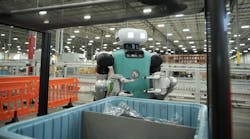Agility Robotics' Digit Shows Promise in Line-Side Operations with New ISO Safety Standard on the Horizon
- Digit can communicate with existing automation systems like Zebra AMRs through cloud-to-cloud signaling, while using QR codes and visual systems for precise positioning and workflow management.
- Agility Robotics is spearheading the development of ISO 25875, a new safety standard specifically for "dynamically stable industrial mobile manipulators" to provide clearer regulatory guidance for this emerging robot category.
- Deployments at GXO and Schaeffler demonstrate these robots’ capabilities in real-world applications.
At Automate 2025, Automation World had the opportunity to speak with Melonee Wise, chief product officer at Agility Robotics. Wise provided insights on a demo showing Digit's application in line-side loading and unloading operations. In this demo, the robot worked with Zebra Technologies' autonomous mobile robots (AMRs) in a coordinated workflow to showcase the potential for human-robot collaboration in manufacturing environments.
"What we're showing demonstrates Digit's ability to unload parts and reload the AMR," Wise explained. The integration between Digit and Zebra's AMR system highlights the two robots’ cloud-to-cloud communications, where completion signals from Digit's cloud platform trigger the next phase of the AMR's operation in a tight operational loop.
Wise also highlighted Digit’s visual capabilities, which including a QR code scanning functionality that enables its precise positioning and navigation within work cells. These QR codes serve a dual purpose: to identify parts and help Digit localize its position relative to equipment, such as flow racks.
The combination of mobility, manipulation capabilities and sophisticated control systems are being positioned to offer manufacturers new options for addressing repetitive tasks while maintaining the flexibility to adapt to changing production requirements.
Central to Digit's operation is Agility Arc, the company's cloud-based automation platform that provides control over Digit’s workflows. This system allows operators to configure work cells by building detailed maps and establishing automated workflows that can be scheduled and monitored in real-time. Reading the Agility Arc screen in the demo, Wise said, “You can see that Digit is moving 66 totes per hour with a cycle success rate between 98% and 100% availability.”
Safety standards for dynamically stable industrial mobile manipulators
For obvious reasons, safety considerations have been paramount in Digit's development. Wise noted the robot’s essential safety features — such as safety lights, emergency stops, and other integrated safety systems — are designed for industrial compliance.
Recently added safety features on Digit include:
- A Category 1 (CAT1) stop, which involves maintaining power to the machine actuators during the deceleration process, allowing the machine to stop smoothly and safely, before removing power.
- A safety PLC, to provide safety functions that meet performance level d (PLd).
- An E-stop button to immediately halt all robot movements and operations in case of an emergency.
- FSoE (FailSafe over EtherCAT) to ensure safe communication between devices over an EtherCAT network.
Agility Robotics has also been taking a proactive approach to robot safety standardization by proposing the development of a new ISO standard specifically for these “dynamically stable industrial mobile manipulators,” the technical term used to accurately describe Digit. "The reason we use that term is because the term ‘humanoid' can be vague," Wise explained. "If I asked you to define what a humanoid is, most people would struggle to do that. For example, does a humanoid have to have legs? Can it have wheels? Does it have to have two arms? That's why we use more technical language to be very clear about what falls under this new standard."
The proposed ISO 25875 standard has been accepted for review and will follow the typical three-year timeline for new ISO standards, with completion expected within four years. However, this timeline doesn't constrain Agility Robotics' continued development efforts centered on Digit’s ability to operate outside a work zone, Wise said.
Digit deployed at GXO and Schaeffler
Real-world deployments of Digit demonstrate the robot’s viability in industrial settings. For example, GXO, a major logistics provider, has been using Digit for more than a year, with Digit successfully moving more than 300,000 orders from their facility. And Schaeffler, a manufacturer of bearings for automotive, aerospace and industrial uses, has been using Digit for several months to handle the loading and unloading of machine washers. Current operational constraints require Digit to work within defined work zones, making it particularly well-suited for repetitive tasks in work cell-sized areas. "Good tasks for Digit now would be those in a work zone where things coming down a line need to be picked and moved to another place in the work zone," Wise noted, acknowledging Digit’s current limitations while hinting at future capabilities.
While current deployments focus on contained work environments, the foundation being established through standardization efforts and real-world testing positions these robots for broader manufacturing integration. As manufacturing facilities continue to deal with labor shortages and the need for flexible automation, robots like Digit could represent a bridge between traditional fixed automation and fully autonomous systems. The combination of mobility, manipulation capabilities and sophisticated control systems are being positioned to offer manufacturers new options for addressing repetitive tasks while maintaining the flexibility to adapt to changing production requirements.
The video of Digit below was captured at Automate 2025.


